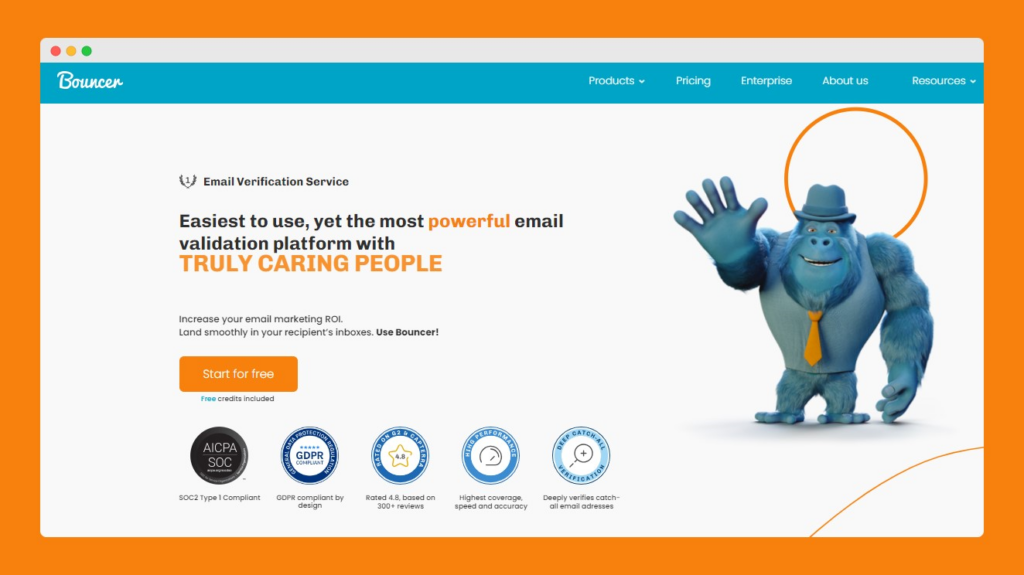Email Marketing Under GDPR: What You Need to Know
People and businesses send personal and sensitive data through email every day. And if it’s your case, security should be a top priority for your company.

However, navigating email marketing under GDPR can be a challenge for businesses. With these regulations, respecting customer data and privacy becomes mandatory.
Let’s discover how to make your email marketing not only compliant but also more effective and gain trust with your customers.
💡 Did you know that, on average, email users send over 170 work-related emails each week? The number is still growing. These emails contain personal data, attachments, and other details like these, which are all protected by the GDPR.
What is the GDPR, and what does it say about email marketing campaigns?
The General Data Protection Regulation (GDPR) is a law in the European Union (EU) that protects personal data and privacy.
It covers how businesses must handle customer data, particularly in activities like email marketing.
Under GDPR, companies need consent from a person (data subject) to use their personal data for email marketing campaigns. The consent means individuals agree to receive marketing emails.
However, GDPR says you can email existing customers without direct consent if there’s a legitimate interest. For potential customers or ‘cold’ contacts, the situation is a bit different – companies usually need individual’s consent before sending marketing emails.
The regulation also protects the rights of individuals over their data. People can ask companies not to use their personal data for direct marketing purposes. If someone objects to their data being used this way, the company must stop using it for marketing but can still use it for other purposes like fulfilling a contract.
Companies must be careful in handling personal data to avoid privacy violations. If a data breach happens, GDPR has strict rules on reporting it and protecting affected individuals in the EU.
Businesses engaging in email marketing must also be transparent about their data collection and use practices. So they need to inform people about how their data will be used and give them control over it. For example, how they collect data for marketing purposes, such as email addresses.
GDPR principles and best practices to follow for responsible email marketing
Following the rules keeps your business safe from legal issues and builds trust with your customers. Respect their privacy to show you’re a reliable business.
There are seven such principles that GDPR requires in order to be fully GDPR compliant:
01 Collect personal data in a legal and fair way. Be open about why you’re collecting it and how it will be used.
02 Only collect data for specific and legitimate reasons. Don’t use it for anything else other than what you initially claim.
03 Only ask for the data you really need and nothing more than that.
04 Keep data up to date and correct any mistakes quickly.
05 Only store data as long as you need it for your stated purposes.
06 Protect data from unauthorized access or accidental loss. Use secure email platforms and limit access to data within your organization.
07 Keep records to show you’re following GDPR rules, like getting consent and explaining how you use data.
When you handle customers’ data with care and honesty, people feel safer sharing their information with you. It’s also a good move for creating customer loyalty.

How to send GDPR-compliant emails?
Now you see that GDPR is a big deal, and it’s a must in email marketing. But how to start sending GDPR-compliant emails?
We’ve got you covered.
#1 Always get user consent before sending out emails
Under the General Data Protection Regulation, you need clear permission from people to use their personal data for direct marketing. They must agree actively to receive your marketing emails. It’s not enough to assume they want them or to use pre-checked boxes.
Why do you want to do this? This step will help you to prevent data breaches and maintain trust in your email marketing campaigns.
#2 Use double opt-in
As soon as someone signs up for your marketing emails, they get a confirmation email to verify their interest. Only after they confirm they are added to your email list. Thanks to this process, you don’t have to worry about the clear consent of the data subject.
Double opt-in consent is great for managing data responsibly and providing data security.
Why should you do this? You demonstrate that you are serious about following data protection principles and respecting data privacy laws in your digital marketing efforts.
#3 Make it easy for people to opt out and unsubscribe (e.g. from a newsletter)
Every email should have a clear way for people to say “no more emails, please.” A simple unsubscribe process stays on the right side of data protection laws.
The best would be a clear, visible unsubscribe link in every email, ideally at the bottom. After unsubscribing, send a confirmation message acknowledging the user’s request.
You can also include a simple feedback form on why they are unsubscribing, but this shouldn’t be mandatory.
Why should you do this? It reduces the risk of unwanted marketing communications, which could be seen as a breach of GDPR compliance.
#4 Validate emails to regularly clean your lists
Checking your list gets you to weed out old or invalid emails. Then, your marketing emails land in the right inboxes, and your data is up-to-date and accurate. You’ll stay compliant with GDPR rules and not send unwanted emails.
Why should you do this? It’s easier to send an email marketing campaign to an audience that is interested in your content. On top of that, you’re not flagged as spam.
And here is one more question to answer: what tool to use for email validation?
We’ve got a strong candidate. 💪
Bouncer is a GDPR-compliant tool great for checking email lists.

It’s also:
- reliable and secure – with a zero downtime policy and SOC2 readiness, it keeps your data safe
- precise with bias against false negatives – Bouncer reduces the wrong categorization, so you stay connected with potential customers
- fast – the tool handles up to 200,000 per hour for each customer
- versatile – it verifies emails from different providers, including Google Workspace and Office365, with few unknowns
- feature-packed – comes with email verification, the deliverability kit, toxicity check, API, integration, and more
Bouncer runs all its operations in Europe, on European servers, fully in line with GDPR. So it’s a solid choice for businesses looking for effective, legally compliant email marketing.

#5 Choose a great email service provider
Look for a provider that understands and complies with the General Data Protection Regulation. A good provider makes it easy to ask for and track consent, safeguards your data, and helps you send out emails that hit the mark while playing by GDPR rules.
Why should you do this? Just to make your life easier and protect your emails to be on the right side of the law. A good email marketing platform and email service provider takes the guesswork out of GDPR, so you can focus on creating great content without worrying about compliance issues.
#6 Be transparent about email content and purpose
Transparency is a basis for trust. Before collecting personal data, communicate clearly the purpose and content of your emails. It makes people understand why and how their data, specifically sensitive personal data, will be used when they provide it.
Tell people straight up what your emails are about – whether they’re for sales, info, or both. They will know you’re taking good care of their confidential information.
Why should you do this? When people know what’s coming in your emails, they are more likely to interact with the content and respond positively to it.
#7 Regularly update your privacy policies
The updates are a sign of showing respect for people’s decisions and responsibly processing personal data, very often sensitive information.
As your email strategy changes, make sure your privacy policies do too, and are clear about how you use personal data.
Why should you do this? Maintain your privacy policies fresh to show you’re serious about looking after data. It helps you stick to email marketing GDPR rules and makes your audience rely on you more. They’ll see you’re dedicated to using their data right and keeping it protected.
#8 Strengthen your data security practices
As a data controller, you’ve got to really enhance the security of the data you use in your email marketing.
Ensure your email marketing strategy is well-defined, specifically when it comes to getting consent. Use safe ways for people to sign up and keep data protection strong at all times.
Why should you do this? Good data security in your emails proves you’re serious about protecting personal info. This builds your reputation as a safe and responsible data controller.
General Data Protection Regulation fines for non-compliance
Organizations need to take GDPR seriously, especially in email marketing, or they could face big fines. Fines can hit up to €20 million or 4% of the company’s global annual turnover.
For instance, a company has a global annual turnover of €100 million. Under GDPR, the maximum fine they could face for non-compliance is either €20 million or 4% of their global annual turnover, whichever is higher. In this case, 4% of €100 million is €4 million. Since €20 million is higher than €4 million, the maximum fine they could face would be €20 million.
How are GDPR Fines determined?
👉 The severity of the breach determines how big the fine is. Authorities look at the nature of the violation – what rules were broken and how serious the breach was.
👉 They consider if sensitive personal data was involved and if the company failed to obtain proper consent from data subjects.
👉 The duration of the violation also matters, along with how many people were affected and how much damage they suffered.
👉 A lot depends on how the company approached the situation – whether they tried to fix the problem and how they handled data processing.
All these factors come together to set the fine amount.

Conclusion on GDPR email marketing
We’ve got email marketing strategies that comply with GDPR rules covered! 🎉
This is an important step – not just for staying legal but for maintaining customer loyalty. The whole point is to guarantee that every marketing communication respects everyone’s privacy and data choices.
And to do this, check out Bouncer! It’s an email list verification platform built with GDPR-friendly practices. It helps clean up your email lists and makes sure the right people get your emails.
Thinking of stepping up email marketing and keeping it GDPR-compliant? Give Bouncer a try and verify the first 10,000 emails for free. It could be just what you need to get your emails on track and keep your audience engaged.





